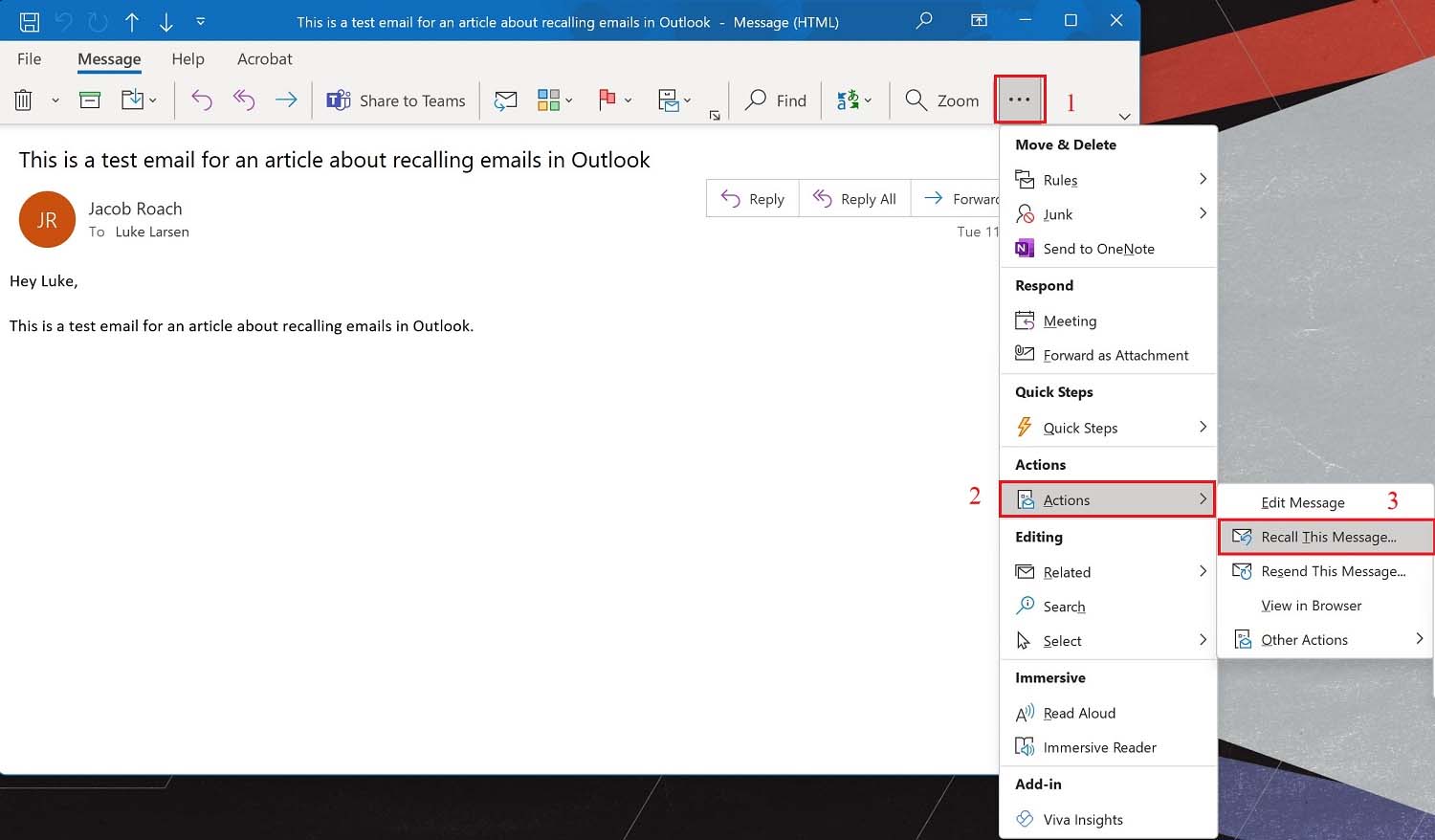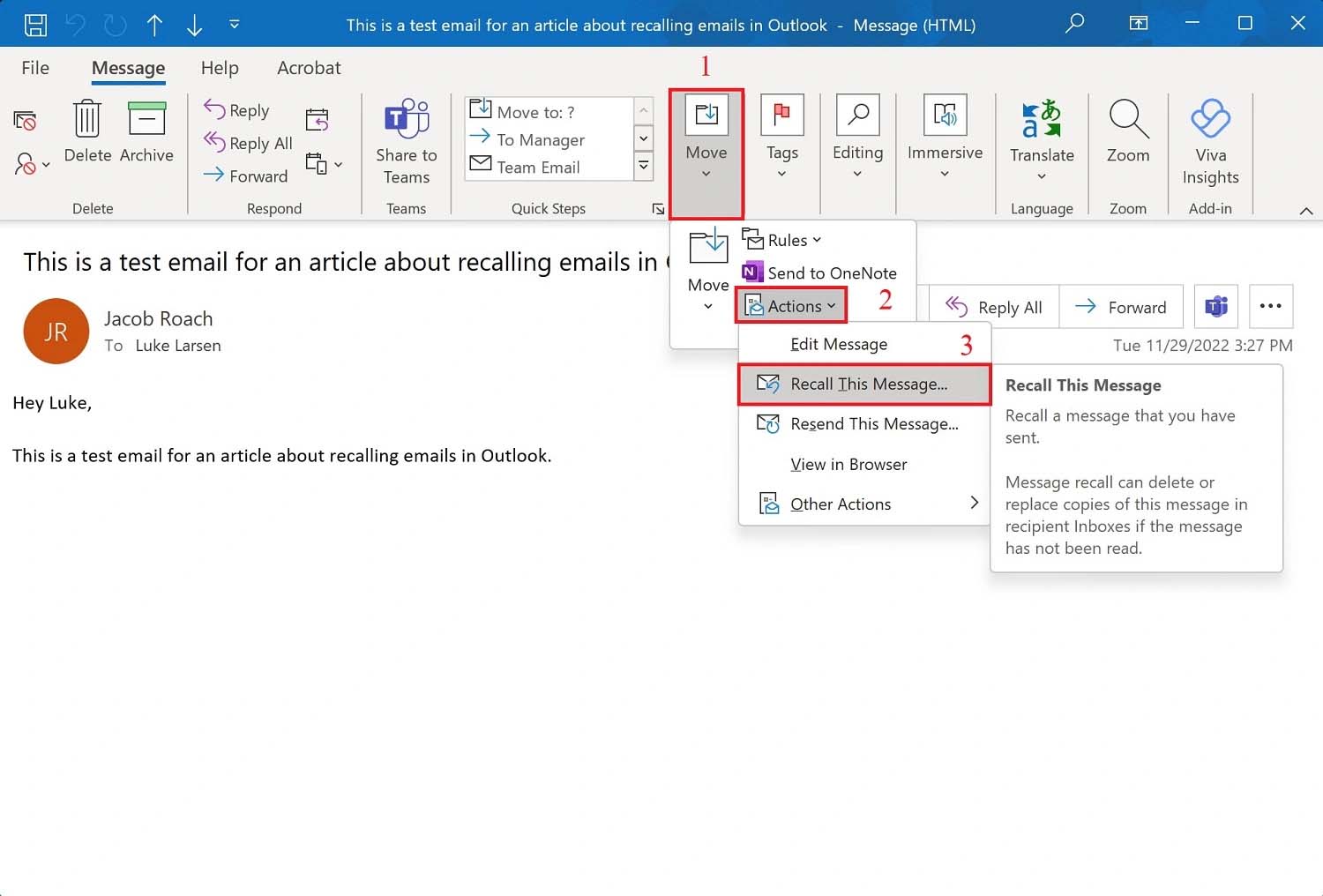Sending personally identifiable information (PII), trade secrets, and other sensitive information via email is often unavoidable, and risky. Should this information be shared with an unauthorized party, your business could be in a lot of trouble, from financial damage to reputation damage and more. It’s for this reason that redaction is so incredibly important - though you can attempt to recall emails in Outlook, proactively redacting them with secure digital tools is even better.
In this article, we’ll share how to use Outlook’s recall function and how to redact emails using a dedicated redaction tool.
Redacting an email: The basics
So, what is email redaction, and when should you do it?
Email redaction is all about removing or obscuring sensitive pieces of information, like personal details or confidential data, from an email. Usually, the unwanted content is covered or replaced by a white or black box so that it’s no longer legible. Learning how to redact emails is vital for maintaining privacy and protecting yourself against potential data breaches or identity theft.
It’s essential to redact your emails if they contain any personally identifiable information like:
- Bank account numbers
- Social security numbers
- ID numbers
- Addresses
- Dates of birth
Ideally, you’ll redact this data before sending an email, not after. Once you’ve clicked “send,” the situation gets a little more complicated.
You cannot redact an email in Microsoft Outlook directly
Microsoft Outlook wasn’t designed for redaction; there’s no function in the software to enable this type of editing. So, you’ll need a different software to clean up your emails before sending them - a dedicated redaction tool.
Redacting vs Recalling
Recalling an email is not the same as redacting it. Redacting means removing any sensitive or personal information from an email before sending it out, while recalling means deleting an email from the recipient’s inbox. Recalling is more of a safety net for when redaction isn’t possible or wasn’t done proactively.
From this point on, we’ll touch on how to recall emails, how to redact sensitive data in an email, and how to redact a document before attaching it to an email.
You can recall an email in Microsoft Outlook
Many business owners and office workers don’t redact emails before clicking “send.” Though this could spell disaster in the worst cases, there is a potential lifeline to explore. If you’re working in Outlook, the application’s recall function could be your saving grace. It allows you to delete a sent message from the recipient’s inbox. You can then send them a replacement email.
You may find this function helpful after you’ve made an error in your email or sent it to the wrong person. However, it's crucial to remember that it's not foolproof and will only work in select situations. We’ll spell it all out as we continue.
How to recall an email in Outlook step by step
If you’re looking to recall a Microsoft Outlook email, read on.
There are four versions of Outlook:
- Classic Outlook
- New Outlook
- Outlook on the web
- Outlook.com.
We’ll cover all of the versions in this section.
Classic Outlook
1. Find the email you want to recall.
Open your “Sent Items” folder and find the email you want to recall.
Double-click the email to open it in a new window.
2. Recall the email
Select the three dots on the top right corner, click the "Actions" button in the top ribbon, and select "Recall This Message."

If you don't see the three dots, select “Move” from the toolbar, then choose “Actions” and “Recall This Message.”

Once you initiate the recall process, a pop-up window will appear on your screen, giving you two options:
- Delete unread copies of this message OR
- Delete unread copies and replace with a new message.
.png)
You can also have Outlook notify you whether the process is successful. Select your desired option(s) and click “OK” to proceed.
If you choose to delete the message, it will be permanently removed. If you want to replace it, you will be directed to a second screen where you can revise the email. Once you're done composing the new email, click “Send.”
New Outlook and Outlook on the web
1. Go to the left folder pane and select “Sent Items.”
2. Double-click the message you want to recall.
3. Look at the ribbon and find a button that says “Recall Message.” It has this icon:

4. Select “OK” in the dialog box that comes up.
5. Look at your inbox to determine the status of your recall. Outlook will send you a status update link there. Click that link for more information.
Outlook.com
You cannot recall a message in Outlook.com. The feature is not available in this version of the application at the time of this writing.
What happens when you recall an Outlook Message?
When you recall a message, the original email doesn't simply go away. The recipient may need to open the new email first for the initial email to disappear. To prevent this, include the word "URGENT" or a similar phrase in the recall message's subject line.
Keep in mind that the recipient may still be notified when the messages are deleted from their inbox. So, even if you recall an email, the recipient may still be aware that a message was sent to them, but they won't be able to view its contents.
Delay email delivery to reduce email errors
Even if you are familiar with how to recall an email via Outlook, remember that you can only make modifications of this type if the email is unread. Once the recipient reads the message, recalling it is out of the question and that sensitive information is vulnerable.
One of the best ways to avoid a situation like this is to delay email delivery so that you’ll have more time to reconsider your messages before they’re actually sent. There’s a Defer Delivery feature in Outlook that allows you to do that.
Follow the instructions on this Microsoft support page to set the feature up for all your Outlook emails.
Note: This feature isn’t available for Outlook.com.
The best approach: redacting emails before sending and using the recall feature
Recalling is a helpful feature that’s available in certain versions of Outlook. While email redaction isn't directly possible in Outlook, redacting sensitive information before sending is a proven way to enhance email security, requiring you to convert email chains into PDFs and then use Redactable to remove that sensitive data. Redactable can be used for redacting any email attachments as long as they are in PDF format.
How to redact emails before sending them using a redaction tool
Now let’s go over the steps involved in redacting emails and PDF email attachments using Redactable, our easy-to-us redaction software.
- Start by opening up the Redactable software and uploading the PDF you want to redact:
- Use the redaction wizard to pinpoint sensitive information. Choose from Manual, Search Text, Patterns, and Auto.
- Select all the items you want to redact.
- Download your newly redacted document and attach it to your email.
How to redact an email before sharing it with a third party
If you want to redact email text before sharing it with a third party, here are the steps you’ll follow:
- Print the document.
- Scan and save the document as a PDF.
- Upload your PDF document to the Redactable software.
- Allow the software to select PII and other information you may want to redact.
- Select the items you’d like to remove using the software’s intuitive interface.
- Download your ready-to-use document.

“An ounce of prevention is worth a pound of cure.” This saying rings especially true for email-based business communication. Redacting your emails in Outlook before clicking “send” protects your firm’s private information, reducing the need to recall messages in the future. A little attention upfront can help you avoid major obstacles down the road. With advanced cloud-based tools like Redactable, the process is easier than it’s ever been!
Redactable Overview
Redactable is a data redaction tool meticulously designed for organizations looking to safeguard sensitive information. This dedicated software application allows you to quickly and easily remove confidential data from PDFs.
Behind the scenes, advanced algorithms detect and redact personally identifiable information (PII), protected health information (PHI), financial data, and other sensitive content.
In addition to that, the software supports automated batch processing, making it easier for organizations to redact multiple files simultaneously.
Redactable isn’t a basic tool - it offers advanced software redaction, allowing users to search for specific keywords or patterns within a document and redact them automatically. And there’s a whole lot more in store.
Features that make Redactable great
1. Redaction Wizard
With our Redaction Wizard, redaction is a cinch—no complex manuals or drawn-out training sessions. Our wizard takes you through the entire process.
Choose from multiple redaction methods, including Manual, Search Text, Categories, and Auto.
2. Redaction Workflow
Keep your redactions organized with our easy-to-use workflow. From task management to setting up a hierarchical review process, managing your redaction projects is effortless.
You can use Folders, Version Control, Tags, Projects, and Stats to stay on top of it all.
3. Collaborative Redaction
Work with your colleagues on large redaction projects using our cloud-based platform. Redaction logs, comment functionalities, task tracking, and collaborative capabilities foster extreme efficiency.
4. Fast Redaction
Redacting can be a time-consuming drag if you don’t have the right tools at your disposal. On average, Redactable users spend only 2.5 minutes redacting a ten-page document! You get to save 98% of your time on each redacting job compared to other redacting tools. Try Redactable for free with 3 free redactions.
Frequently asked questions
Q: What is the redacted meaning in the context of emails?
A: Redaction in the case of emails refers to eliminating or covering up sensitive text and images to keep them secure. It comes in handy when you want to remove trade secrets or confidential information before distributing text or documentation to your team via email.
Q: Can I redact on a Google document?
A: You can certainly do small-scale redactions on a Google document. Just click and drag your cursor to select the text you want to redact, then click the highlight icon and select the color to black. That text you highlighted won’t be readable to others, so long as you share the content with view-only permissions. If you send the document to someone else in editor mode, they’ll be able to remove the highlighted portions, leaving your information vulnerable.







